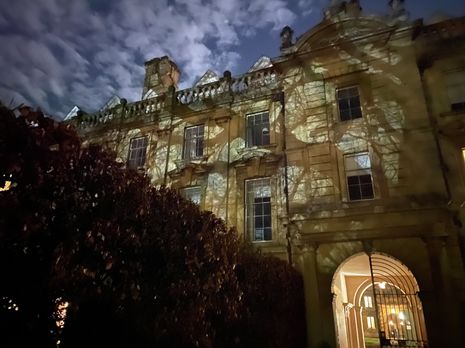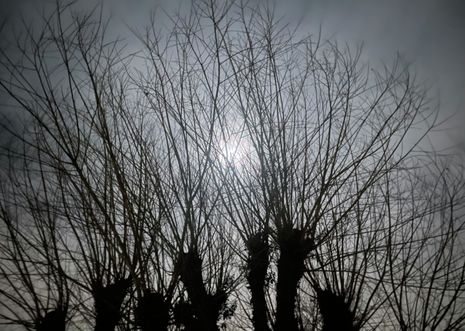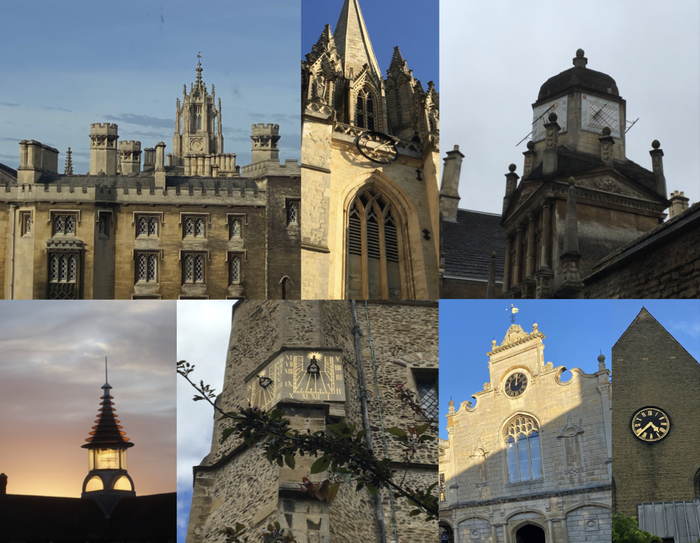Ghost Cam: Your guide to the supernatural in Cambridge
Esther Arthurson ranks Cambridge’s most haunted colleges and reflects on the buried memories unique to every place

It is commonly acknowledged that Cambridge is a place of great suffering and unresolved trauma. If you’ve ever been at a 9am on a Thursday morning, you’ll know exactly what haunted looks like. (In this case, haunted by tequila, regrets, and memories of sandwich-wielding Christians flanking the exit that you’re pretty sure were a hallucination.)
When it comes to mortality, we need look no further than the Corpus Clock. With every stroke of the delightfully morbid hammer on the coffin that lies behind its hideous visage, our precious time is ticking away, each beat a footstep taking us one step closer to whatever lies on the other side. We bustle on past, blocking our ears to the proverbial ticking, but there is something deep inside us that will not allow us to forget – this thing, gaining on us one inch at a time, generally considered to be faceless, anonymised by the darkness in which it shrouds itself. But if this hunter did have a face, I reckon it would look something like the creature striding atop that ghastly clock: waiting. Relentless. Untiring. Forever closing the gap.
“We all knew Peterhouse was a home for troubled souls”
Cambridge is a place on the edge – and I’m not referring to its temperamental student population. Cambridge as a settlement was historically situated on the face of a vast moorland, the remnants of which we can see in the Fens; the final frontier of humanity, forming a liminal space in which two worlds collide. On draining the Fens, dozens of trinkets long ago surrendered to the marsh were discovered, later identified as pagan tokens used to ward off evil spirits. And spirits only grow stronger with time.
If you scratch the surface, you can trace Cambridge’s bruises back through the centuries in a constellation of unresolved pain. All of it tragic – but how much is true? That’s up to you. Now, without further ado, I give you Cambridge’s most haunted colleges ...
1) Peterhouse:
As the oldest Cambridge college, its spot as number one is hardly surprising. We all knew Peterhouse was a home for troubled souls. Peterhouse is known to have conducted at least three exorcisms in its time, one of which caused such a stir that it was reported by the BBC in 1997, performed to alleviate a presence that was thought responsible for an unprecedented bout of depression amid the residents. The College’s location on the brink of the Fens – that borderland where things get … stuck – and adjacent to Little St Mary’s Lane, a supernatural highway according to local ghost tour guides, makes it a particular spiritual flash-point. The lane is a regular hangout for the “Black Shuck”, which is the polite term for “demon dog”. If you see this particular wagging tail, you’d better get working on your bucket list, because rumour says you’ll only have a year left to complete it. (Thank goodness for shortsightedness – can I get an amen?) We can only hypothesise the backstory for this furry fiend, because, obviously, dogs can’t talk. Immortal demon dog, sure. Immortal talking demon dog, and you’re just pulling my leg. But it goes with out saying that Shucky probably wasn’t a very good boy.

The lane boasts various other spectres, including the lady in white, whose identity has also been lost to the tides of history. She certainly isn’t the lane’s eponymous Mary, because when you try calling her that she gets really pissed. The graveyard here is also a cause for concern, but that’s another article in itself.
2) Corpus Christi:
Corpus: home to a high percentage of Firsts, a number of disgruntled (dead) residents, and the world’s most aesthetically challenged clock. Its grounds include a built-in graveyard and the oldest building in Cambridge (St Bene’t’s). Three spectral inhabitants are particularly infamous among porters, two of whom are the victims of a 17th-century love-story-gone-wrong. Catherine Spencer, the master’s daughter, and James Betts’ clandestine fling was brought to an abrupt halt when James hid himself in a mahogany chest to avoid the discovery and wrath of her father upon his unexpected return home. Catherine came back to find her lover dead from suffocation – that’s one way to let the cat out the bag re your relationship (or rather, let the boyfriend out the box). Heartbroken, Catherine soon followed her soulmate, departing of a nervous breakdown only a few months later, and is buried in St Bene’t’s cemetery. The two lovers, reunited in death, can be seen smooching around college grounds, pulling behind pillars, and are fairly harmless. If you hear a pair of footsteps, you’ll know you’re safe. But a lonely set of plodders, and you’re in trouble …
Henry Butts was master of Corpus in the 16th to 17th century, and had to deal with the olden equivalent of a Covid outbreak – although I imagine remote learning was a tad tricker back then – when the bubonic plague made its deadly visit to Cambridge in 1630. Students were evacuated, teaching suspended. Butts volunteered to stay behind and help the sick while Corpus became a makeshift hospital for plague victims. He was completely isolated, passing his nights alone in the master’s lodge and his days amid the dying. A genuine hero. He took his own life once things had returned to normal, failing to turn up at Great St Mary’s (his holy side hustle) to give the Easter morning sermon. Well, you know the deal with Easter Sunday – do I hear a resurrection? Such great suffering as Butts witnessed leaves a mark on all involved – is it any wonder that such pain never quite finds its way out? Butts can be seen roaming the grounds today, identifiable through his white doctor’s coat, plague mask, and his bruised, swollen neck.
3) King’s:
King’s … need I say more? Or did I just achieve a one-word horror story? Cambridge is home to many eccentrics, but none quite as unusual as the memory of Mr Barrett. (Papers explaining this particular story can be found in the UL, the basis for MR James’s Casting the Runes.) He is a one-man answer to why the Gibbs Building is now uninhabited, used for day-time supervisions only. Barrett took his goth phase to the extreme, indulging an unhealthy interest in the occult by keeping a pet coffin (ancient ancestor of the bean bag, perhaps?) in his room. He kept his neighbours up at night, screaming and screaming for hours on end. (Very much a case of don’t ask, don’t know.) But the real trouble came when one night, he suddenly stopped screaming. He was found in his coffin, smiling at the ceiling through unseeing eyes. Every year, on this anniversary, his cries can be heard once again, reverberating the entire stairwell, no doubt issued through that ghastly, smiling mouth, hence the building’s prompt evacuation. The moral of this story: avoid the eccentrics.
“The moral of this story: avoid the eccentrics”
So there you have it. Tread carefully, for you are walking on history or, in some cases, graves – Midsummer Common was once a mass burial ground for Black Death victims, after all. And remember to stop every now and then, between pub trips and supervisions, to acknowledge that relentless ticking, that hideous clock where we started and where all things must end. And, when you do so, make sure to look behind you.
 News / SU reluctantly registers controversial women’s soc18 December 2025
News / SU reluctantly registers controversial women’s soc18 December 2025 News / CUP announces funding scheme for under-represented academics19 December 2025
News / CUP announces funding scheme for under-represented academics19 December 2025 News / Cambridge welcomes UK rejoining the Erasmus scheme20 December 2025
News / Cambridge welcomes UK rejoining the Erasmus scheme20 December 2025 Features / Should I stay or should I go? Cambridge students and alumni reflect on how their memories stay with them15 December 2025
Features / Should I stay or should I go? Cambridge students and alumni reflect on how their memories stay with them15 December 2025 Film & TV / Timothée Chalamet and the era-fication of film marketing21 December 2025
Film & TV / Timothée Chalamet and the era-fication of film marketing21 December 2025










